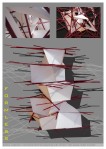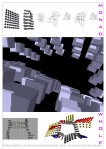8th semester
Instructor: Yannis Zavoleas
Theme subject: Systemic approaches in architectural design. Archetypical schemas and their transference to space
Short Description
In the research framework outlined by a systematic understanding of space design, the course focuses on an analysis of archetypical schemas coined in the modern and the late modern era. Archetypes with reference to the grid, also to linear arrangements and their derivatives such as the web, the mat and the matrix, were developed as schematic interpretations of verbal descriptions about space, being descriptive of its structure. The related quest has evolved over the last twenty years. Advanced archetypical systems have been generated, whose nominative characteristics respond to contemporary issues about architectural design, also to a variety of conditions and qualities describing space, including the relationships among its units.
In reflection of the above, new archetypical alternatives are investigated over the course. As a general observation, there is a shift of interest concerning design methodologies. Specifically, an interest in preset typologies describing space would give way to a quest of its inner logic, stemming from the interaction among the parameters about an architectural project, thereby bridging the gap between analysis and synthesis.









































































































